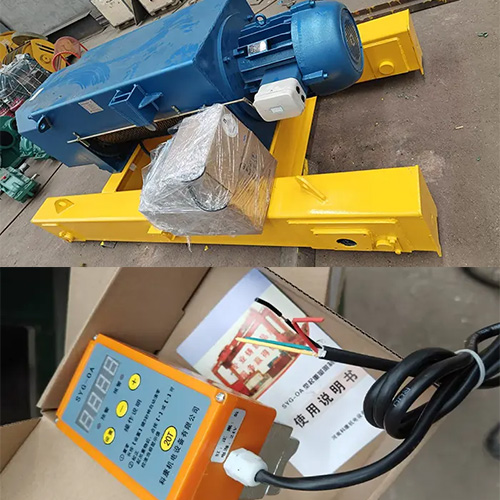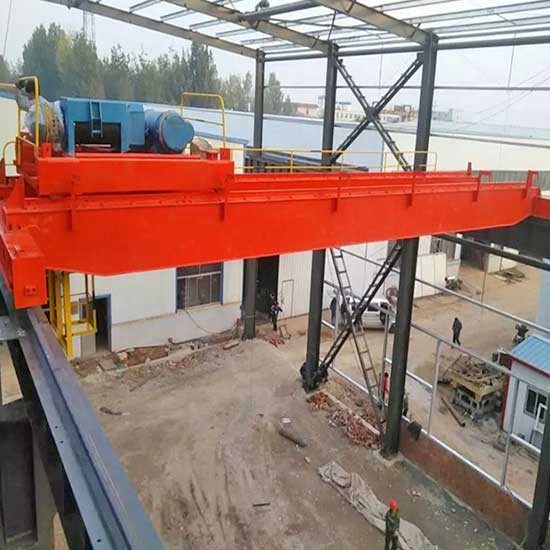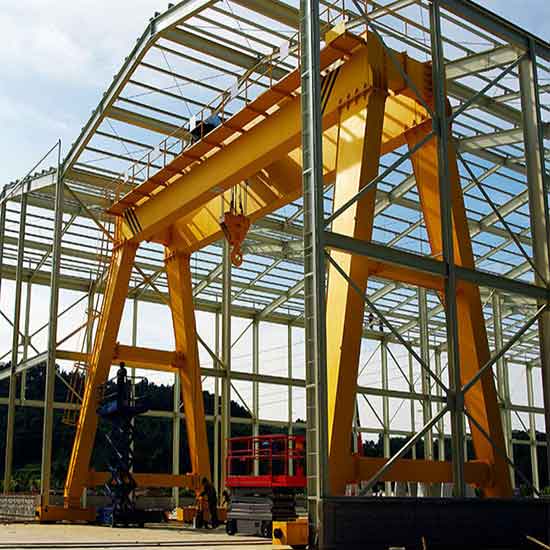Remote Control 20 Ton Hoist for Double Girder Crane for Sale Peru
Remote control 20 ton hoist for double girder crane. Customized wire rope electric hoist for sale Peru for particular use.
Category: Wire Rope Hoist Crane
Your Trusted Wire Rope Hoist Crane Manufacturer & Supplier
Remote Control 20 Ton Hoists for Double Girder Cranes for Sale Peru
Remote control 20 ton hoist for double girder crane. Customized wire rope electric hoist for sale Peru for particular use. Get your wire rope hoist now. Remote control 20 ton hoists for double girder cranes for sale. With intuitive remote control functionality, operators can command the hoist from a safe distance, maximizing efficiency and safety on the job site.
Double girder cranes are workhorses of industrial settings, relied upon for their strength and versatility. To complement these mighty structures, custom wire rope hoists step in as indispensable partners. Engineered to seamlessly integrate with double girder cranes, these hoists offer tailored solutions for lifting heavy loads with precision and reliability. Their adaptability ensures smooth operation, enabling businesses to meet demanding lifting requirements with confidence.
Overview of 20 Ton Hoists for Peru: A Case for Your References
CD/MD Wire Rope Hoist:
Among the diverse array of 20 ton hoists, the CD/MD wire rope hoist stands out as a stalwart choice. Engineered for durability and performance, these hoists are designed to handle heavy loads with precision and ease.
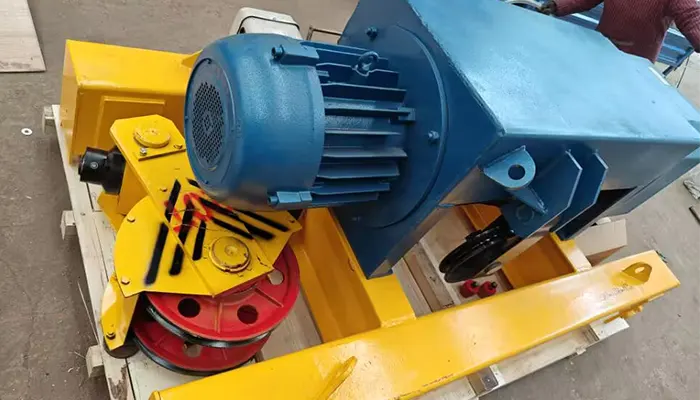
Features:
- Robust Construction: Built to withstand the rigors of industrial environments, CD/MD wire rope hoists boast sturdy construction, ensuring longevity and reliability.
- Smooth Operation: Equipped with advanced mechanisms, these hoists offer smooth and controlled lifting, enhancing operational efficiency.
- Versatility: From mining operations to construction sites, CD/MD wire rope hoists excel in diverse applications, adapting seamlessly to varying project requirements.
Benefits:
- Enhanced Productivity: With their ability to lift heavy loads effortlessly, CD/MD wire rope hoists boost productivity, minimizing downtime and maximizing output.
- Safety Assurance: Rigorous quality standards and safety features ensure safe operation, mitigating risks and safeguarding personnel and assets.
- Cost-Effectiveness: Despite their robust performance, CD/MD wire rope hoists offer cost-effective solutions, delivering value for investment over the long term.
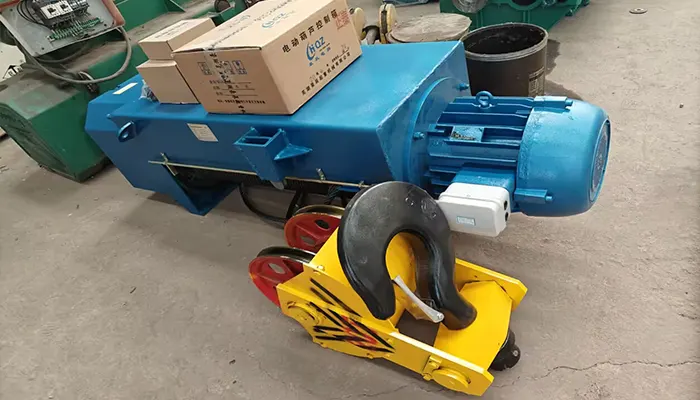
Hoist Power Supply Requirements:
440V, 60Hz, 3 Phase:
The power supply requirements of 440V, 60Hz, 3 Phase are standard specifications for 20 ton hoists in Peru. This voltage and frequency configuration is optimized for industrial settings, providing the necessary power to drive the hoist motors efficiently.
Implications for Installation and Operation:
- Compatibility: Ensuring that the power supply aligns with the hoist specifications is crucial for seamless installation and operation. Matching the voltage and frequency requirements prevents potential issues such as motor overheating or underperformance.
- Electrical Infrastructure: Prior to installation, it's essential to assess the existing electrical infrastructure to verify compatibility and make any necessary upgrades or adjustments.
- Operational Efficiency: By adhering to the prescribed power supply specifications, operators can optimize the performance of the hoist, maximizing efficiency and minimizing energy consumption.
In the dynamic industrial landscape of Peru, the choice of 20 ton hoists is a strategic decision with far-reaching implications for operational success. By understanding the types, features, and power supply requirements of these hoists, businesses can make informed decisions that propel their operations forward with confidence and reliability.

Remote Control Technology
In the ever-evolving landscape of industrial operations, remote control technology has emerged as a game-changer, revolutionizing the way heavy machinery is operated and controlled.
Advantages of Remote Control:
Remote control technology offers a plethora of advantages, enhancing efficiency, safety, and productivity in industrial settings:
- Enhanced Operator Safety: By enabling operators to control machinery from a safe distance, remote control technology minimizes the risk of accidents and injuries associated with manual operation in hazardous environments.
- Improved Precision and Control: Remote control systems provide operators with precise control over machinery movements, allowing for delicate maneuvers and fine adjustments with ease and accuracy.
- Increased Productivity: With remote control technology, operators can streamline workflows and optimize productivity by reducing downtime and maximizing equipment utilization.
- Accessibility and Flexibility: Remote control systems empower operators to control machinery from various vantage points, enhancing accessibility and flexibility in diverse operational scenarios.
- Real-time Monitoring and Feedback: Advanced remote control systems offer real-time monitoring and feedback, allowing operators to assess performance metrics and troubleshoot issues promptly.
Safety Considerations with Remote Control Operation:
While remote control technology offers numerous benefits, it also introduces unique safety considerations that must be addressed:
- Training and Certification: Operators must undergo comprehensive training and certification programs to ensure they are proficient in remote control operation and aware of safety protocols and procedures.
- System Redundancy and Fail-safes: Remote control systems should incorporate redundant safety features and fail-safes to mitigate the risk of system failures or malfunctions.
- Emergency Stop Mechanisms: Remote control units should be equipped with emergency stop buttons or switches that allow operators to halt machinery operations immediately in case of emergencies or safety hazards.
- Environmental Factors: Operators must consider environmental factors such as weather conditions, terrain, and visibility when utilizing remote control technology to ensure safe and effective operation.
- Regular Maintenance and Inspection: Remote control systems should undergo regular maintenance and inspection to identify and address potential safety hazards or issues before they escalate.
By understanding the advantages, types, and safety considerations associated with remote control technology, industrial operators can harness the full potential of this transformative technology while prioritizing safety and efficiency in their operations.
Customization for Double Girder Cranes
In Peru, the customization of double girder cranes plays a pivotal role in meeting the diverse needs and challenges of various industries.
Peru boasts a rich and diverse industrial landscape, encompassing a wide range of sectors that rely on heavy machinery for their operations. Understanding the unique characteristics of Peru's industrial environment is essential for customizing double girder cranes to meet specific requirements effectively.
Key Industries Utilizing Double Girder Cranes:
- Mining: Peru is renowned for its abundant mineral resources, making the mining industry a cornerstone of the country's economy. Double girder cranes are indispensable in mining operations, facilitating the handling and transportation of heavy loads such as ore, equipment, and infrastructure components.
- Construction: With ongoing infrastructure development projects across the country, the construction industry in Peru is thriving. Double girder cranes play a vital role in construction sites, enabling the lifting and placement of structural elements, building materials, and machinery with precision and efficiency.
- Manufacturing: Peru's manufacturing sector encompasses a diverse range of industries, including automotive, aerospace, textiles, and food processing. Double girder cranes are integral to manufacturing processes, facilitating material handling, assembly, and production line operations.
Challenges and Requirements in Peru's Industrial Sector:
Peru's industrial sector faces several unique challenges and requirements that necessitate customized solutions for double girder cranes:
- Altitude Considerations: Many industrial operations in Peru are located in high-altitude regions, presenting challenges such as reduced air density and lower atmospheric pressure. Customized double girder cranes must be designed to operate effectively at high altitudes, ensuring optimal performance and safety.
- Environmental Conditions: Peru's diverse climate, ranging from coastal desert regions to mountainous terrain, poses challenges for industrial equipment due to factors such as temperature fluctuations, humidity, and exposure to corrosive elements. Customized double girder cranes must be engineered to withstand these environmental conditions, incorporating protective coatings, corrosion-resistant materials, and climate control features as necessary.
- Regulatory Compliance: Peru's industrial sector is subject to stringent regulatory requirements aimed at ensuring safety, environmental protection, and compliance with industry standards. Customized double girder cranes must adhere to these regulations, incorporating safety features, certifications, and documentation to meet legal and regulatory obligations.
By understanding the key industries utilizing double girder cranes and addressing the unique challenges and requirements within Peru's industrial sector, customized solutions can be developed to enhance efficiency, safety, and productivity in industrial operations.
Environmental Factors and Their Impact on Hoist Design:
Environmental factors play a significant role in shaping the design and performance of hoists, particularly in the challenging terrain and climate of Peru. Let's explore how altitude considerations and climate conditions impact hoist design, ensuring optimal performance and reliability in diverse environmental settings.
Altitude Considerations: Effects on Hoist Performance and Efficiency
Peru's rugged landscape is characterized by varying altitudes, with industrial operations often situated at high elevations. Altitude considerations can have profound effects on hoist performance and efficiency due to reduced air density and atmospheric pressure:
- Reduced Lifting Capacity: At higher altitudes, the density of air decreases, resulting in reduced lifting capacity for hoists. This phenomenon, known as altitude derating, can significantly impact the hoist's ability to lift loads effectively.
- Increased Power Requirements: To compensate for the reduced lifting capacity at higher altitudes, hoists may require additional power to achieve the desired lifting performance. Hoist motors may need to be uprated to ensure sufficient power output for lifting heavy loads in low-density air conditions.
- Enhanced Cooling Systems: Operating at high altitudes can lead to increased heat generation within hoist motors due to the reduced cooling effect of thin air. Customized hoists designed for use in high-altitude environments may incorporate enhanced cooling systems to dissipate heat effectively and prevent overheating.
Climate Conditions: Adaptations for Extreme Temperatures and Humidity
Peru's diverse climate encompasses a wide range of temperature extremes and humidity levels, posing challenges for hoists operating in outdoor and indoor environments:
- Temperature Extremes: From the arid desert regions along the coast to the frigid Andean highlands, Peru experiences significant temperature variations. Hoists must be designed to withstand extreme temperatures, incorporating insulation, heat-resistant materials, and temperature control mechanisms to ensure reliable operation in hot or cold environments.
- Humidity and Corrosion Resistance: Peru's coastal regions are characterized by high humidity levels, which can accelerate corrosion and degradation of hoist components. Customized hoists may incorporate corrosion-resistant materials, protective coatings, and seals to mitigate the effects of humidity and extend the lifespan of the equipment.
- Severe Weather Protection: Peru is prone to severe weather events such as heavy rain, storms, and high winds, which can pose safety hazards and damage hoist equipment. Hoists designed for outdoor use must be rugged and weatherproof, with features such as waterproof enclosures, sealed bearings, and wind-resistant designs to withstand harsh weather conditions.
By addressing altitude considerations and climate conditions in hoist design, customized solutions can be developed to ensure optimal performance, efficiency, and durability in Peru's challenging environmental landscape.
Regulatory Environment and Compliance Standards:
Compliance with regulatory requirements is paramount in the design and operation of hoists in Peru's industrial sector. Let's explore the occupational safety and health regulations and environmental standards that govern industrial equipment, ensuring the safety of personnel and environmental protection.
Occupational Safety and Health Regulations:
Occupational safety and health regulations in Peru are designed to protect workers from workplace hazards and ensure safe working conditions. Key regulations governing the design, installation, and operation of hoists include:
- Occupational Safety and Health Law (Law No. 29783): This comprehensive legislation establishes the legal framework for occupational safety and health in Peru. It outlines the rights and responsibilities of employers and employees, sets forth requirements for hazard identification and risk assessment, and mandates the implementation of preventive measures to mitigate workplace risks.
- Technical Safety Regulations for Industrial Machinery and Equipment: These regulations provide specific requirements and guidelines for the design, installation, operation, and maintenance of industrial machinery and equipment, including hoists. They cover aspects such as structural integrity, electrical safety, emergency stop mechanisms, and safety devices to prevent accidents and ensure compliance with international standards such as ISO and ANSI.
- Occupational Safety and Health Management Systems: Employers are required to implement occupational safety and health management systems (OSHMS) to identify, assess, and control workplace hazards effectively. OSHMS must include measures for training and certification of personnel, emergency preparedness, and ongoing monitoring and evaluation of safety performance.
Environmental Regulations for Industrial Equipment:
In addition to occupational safety and health regulations, environmental standards govern the use of industrial equipment to minimize environmental impact and ensure sustainable operations. Key environmental regulations applicable to hoists include:
- Environmental Impact Assessment (EIA) Regulations: Industrial projects, including those involving the installation or operation of hoists, are subject to environmental impact assessment requirements. EIAs evaluate the potential environmental effects of proposed projects and prescribe measures to mitigate adverse impacts on air quality, water resources, biodiversity, and ecosystems.
- Waste Management Regulations: Industrial activities generate waste materials that may pose environmental hazards if not managed properly. Hoist manufacturers and operators must comply with regulations governing the collection, storage, transportation, treatment, and disposal of hazardous and non-hazardous waste generated during hoist installation, maintenance, and decommissioning.
- Pollution Prevention and Control Measures: Hoists must be designed and operated in accordance with pollution prevention and control measures to minimize emissions of pollutants such as noise, vibration, dust, and exhaust gases. Environmental permits may be required for certain industrial activities, specifying emission limits and monitoring requirements to ensure compliance with regulatory standards.
By adhering to occupational safety and health regulations and environmental standards, hoist manufacturers and operators can promote a culture of safety, protect the environment, and comply with legal requirements to avoid penalties and liabilities.
Cultural and Socio-Economic Factors:
Cultural and socio-economic factors play a crucial role in shaping the industrial landscape of Peru and influencing decisions related to workforce training, skill levels, and equipment investment. Let's explore how these factors impact the customization of hoists for double girder cranes in Peru's industrial sector.
Workforce Training and Skill Levels:
In Peru, workforce training and skill levels are influenced by cultural norms, educational opportunities, and industry-specific requirements. Key considerations related to workforce training for hoist operation include:
- Technical Education and Vocational Training: Peru's education system offers technical and vocational training programs that equip individuals with the skills and knowledge needed to operate industrial equipment, including hoists. Vocational schools and technical institutes provide specialized training in areas such as mechanical engineering, electrical systems, and occupational safety.
- On-the-Job Training and Certification: Employers play a crucial role in providing on-the-job training and certification programs to ensure that workers are proficient in hoist operation and safety procedures. Training initiatives may include classroom instruction, hands-on practical experience, and competency assessments to verify skills proficiency.
- Cultural Attitudes Toward Safety: Cultural attitudes toward safety and risk management may influence the adoption of safety protocols and practices in the workplace. Employers must promote a culture of safety, emphasizing the importance of following safety procedures and prioritizing the well-being of workers.
Economic Drivers Influencing Equipment Investment Decisions:
Economic factors and market dynamics play a significant role in influencing equipment investment decisions in Peru's industrial sector. Key economic drivers impacting hoist customization and investment decisions include:
- Market Demand and Industry Trends: Demand for hoists and other industrial equipment is driven by market trends, economic growth, and industry-specific requirements. Industries such as mining, construction, and manufacturing drive demand for hoists to support their operations and infrastructure development projects.
- Return on Investment (ROI) Considerations: Companies evaluate the potential return on investment when making decisions about equipment acquisition and customization. Factors such as the expected lifespan of hoists, maintenance costs, operational efficiency gains, and productivity improvements contribute to ROI calculations.
- Government Policies and Incentives: Government policies, incentives, and investment promotion programs may influence equipment investment decisions by offering tax incentives, subsidies, or financing options to support industrial development initiatives. Companies may take advantage of these incentives to offset the costs of equipment acquisition and customization.
By considering cultural and socio-economic factors such as workforce training and skill levels, as well as economic drivers influencing equipment investment decisions, hoist manufacturers and operators can make informed decisions to tailor hoists for double girder cranes to meet the unique needs and requirements of Peru's industrial sector.
Project Location Specifics:
When customizing hoists for double girder cranes in Peru, it's essential to consider the specific characteristics of the project location. Factors such as geographical considerations, customer requirements, and the availability of local suppliers and support infrastructure can significantly impact the design, installation, and operation of hoists. Let's explore these aspects in detail:
Geographical Considerations for Installation and Operation:
Peru's diverse geography presents unique challenges and opportunities for hoist installation and operation. Key geographical considerations include:
- Altitude and Terrain: Peru's rugged terrain and varying altitudes require hoists to be robustly engineered to withstand challenging environmental conditions. Hoists installed in mountainous regions must be designed for high-altitude operation and adapted to the specific terrain characteristics to ensure optimal performance and safety.
- Accessibility: The accessibility of project sites, particularly in remote or hard-to-reach areas, can impact hoist installation logistics and transportation requirements. Hoist manufacturers and operators must assess site accessibility and plan accordingly to ensure timely and cost-effective installation and operation.
- Environmental Impact: Project locations near environmentally sensitive areas such as forests, rivers, or protected habitats require special consideration to minimize environmental impact during hoist installation and operation. Environmental assessments and mitigation measures may be necessary to comply with regulatory requirements and preserve natural resources.
Customer Requirements and Expectations in Peru's Market:
Customer requirements and expectations is critical for delivering customized hoist solutions that meet the specific needs of Peru's industrial market. Key considerations include:
- Load Capacity and Application: Customer requirements for hoist load capacity, lifting height, speed, and precision vary depending on the specific application and industry sector. Hoist manufacturers must collaborate closely with customers to understand their unique requirements and design hoists tailored to their operational needs.
- Safety and Reliability: Safety is paramount in Peru's industrial sector, and customers expect hoists to meet rigorous safety standards and reliability criteria. Hoist manufacturers must prioritize safety features, compliance with regulatory requirements, and reliability in their design and engineering processes to instill confidence in customers.
- Cost-Effectiveness: In a competitive market environment, customers in Peru seek hoist solutions that offer value for money, balancing upfront investment costs with long-term performance and durability. Hoist manufacturers must demonstrate the cost-effectiveness of their products through competitive pricing, efficient operation, and low maintenance requirements.
Local Suppliers and Support Infrastructure Availability:
The availability of local suppliers and support infrastructure can significantly impact hoist customization, installation, and maintenance in Peru. Key considerations include:
- Supply Chain Logistics: Access to local suppliers of hoist components, spare parts, and maintenance services is essential for ensuring timely delivery, installation, and ongoing support for hoist systems. Hoist manufacturers must establish partnerships with reliable local suppliers and distributors to streamline supply chain logistics and minimize lead times.
- Technical Expertise and Support: Local availability of skilled technicians, engineers, and service providers with expertise in hoist installation, maintenance, and repair is critical for ensuring the smooth operation of hoist systems. Hoist manufacturers must provide comprehensive training and technical support to local service teams to address customer needs effectively.
- Infrastructure Facilities: The availability of infrastructure facilities such as warehouses, workshops, and service centers equipped with hoist testing and maintenance equipment enhances the efficiency and effectiveness of hoist customization, installation, and servicing operations. Hoist manufacturers must assess local infrastructure availability and invest in facilities as needed to support customer requirements.
By considering project location specifics such as geographical considerations, customer requirements, and the availability of local suppliers and support infrastructure, hoist manufacturers can deliver customized solutions that meet the unique needs and challenges of Peru's industrial market, ensuring reliability, safety, and cost-effectiveness throughout the hoist lifecycle.
Installation and Maintenance
Proper installation and ongoing maintenance are essential for ensuring the optimal performance, safety, and longevity of 20 ton hoists in Peru's industrial settings. Let's explore the pre-installation checklist, installation process, and regular maintenance procedures to maximize the reliability and efficiency of hoist systems.
Pre-Installation Checklist:
Before commencing the installation of 20 ton hoists, thorough preparation is crucial to ensure a smooth and successful installation process. Key items on the pre-installation checklist include:
- Site Assessment: Conduct a comprehensive assessment of the installation site, considering factors such as accessibility, terrain, environmental conditions, and proximity to power sources and support infrastructure.
- Hoist Inspection: Inspect the hoist components and accessories to verify their condition and functionality, ensuring that all parts are intact and free from damage or defects.
- Safety Measures: Implement safety measures to protect personnel and equipment during installation, including the use of personal protective equipment (PPE), barricades, and signage to delineate work areas and hazards.
- Equipment Readiness: Ensure that all necessary equipment, tools, and materials required for hoist installation are readily available and in good working condition, including lifting equipment, fasteners, and electrical components.
- Regulatory Compliance: Verify compliance with local regulations, codes, and standards governing hoist installation and operation, obtaining any necessary permits or approvals from regulatory authorities.
Installation Process for 20 Ton Hoists:
The installation process for 20 ton hoists involves several key steps to ensure proper setup and integration with double girder cranes. The installation process typically includes the following:
- Mounting and Positioning: Position the hoist unit securely on the double girder crane, ensuring proper alignment and balance to support the intended load capacity and minimize stress on the crane structure.
- Electrical Connection: Connect the hoist to the power supply according to the manufacturer's specifications, ensuring proper voltage, phase, and grounding to prevent electrical hazards and ensure reliable operation.
- Rigging and Attachment: Rig the hoist's wire rope or chain to the load, ensuring proper attachment and alignment to facilitate smooth lifting and lowering operations without excessive strain or imbalance.
- Testing and Calibration: Conduct comprehensive testing and calibration of the hoist system to verify its performance and functionality, including load testing, speed adjustment, and safety feature validation.
- Documentation and Training: Document the installation process and provide training to operators and maintenance personnel on hoist operation, safety procedures, and maintenance requirements to ensure safe and efficient operation.
Regular Maintenance Procedures:
Regular maintenance is essential for preserving the performance and reliability of 20 ton hoists over time. Key maintenance procedures include:
Inspection Schedule:
- Establish a regular inspection schedule to assess the condition of hoist components, identify potential issues, and prevent equipment failures or downtime.
- Inspect critical components such as wire ropes, hooks, brakes, motors, and electrical systems for signs of wear, corrosion, or damage.
- Conduct thorough visual inspections and functional tests according to the manufacturer's recommendations and industry best practices.
Lubrication Requirements:
- Implement a lubrication regimen to ensure proper functioning and longevity of moving parts, including gears, bearings, sheaves, and wire ropes.
- Use lubricants recommended by the hoist manufacturer, applying them at specified intervals and in appropriate quantities to minimize friction and wear.
- Monitor lubricant levels and replenish as needed, avoiding over-lubrication or contamination that could compromise hoist performance and safety.
By adhering to the pre-installation checklist, following the installation process guidelines, and implementing regular maintenance procedures, operators can optimize the performance, reliability, and safety of 20 ton hoists in Peru's industrial environments, maximizing productivity and minimizing downtime.
Safety Protocols
Safety is paramount in the operation of 20-ton hoists for double girder cranes. Implementing comprehensive safety protocols ensures the protection of personnel and equipment. Let's explore the key components of safety protocols, including operator training, emergency procedures, and compliance with local regulations and standards.
Training for Operators:
Proper training for operators is essential to ensure safe and effective operation of 20-ton hoists. Training programs should cover the following areas:
- Equipment Familiarization: Operators should receive thorough training on the operation, controls, and safety features of the hoist, including emergency stop mechanisms, limit switches, and load capacity ratings.
- Safety Procedures: Operators must be trained in safety protocols and procedures, including pre-operation inspections, proper rigging techniques, load handling practices, and hazard recognition.
- Emergency Response: Training should include instruction on responding to emergencies such as equipment malfunctions, power failures, or personnel injuries. Operators should be familiar with emergency stop procedures, evacuation protocols, and communication channels for summoning assistance.
- Regulatory Compliance: Operators should be educated on relevant regulatory requirements, industry standards, and best practices for hoist operation to ensure compliance and mitigate risks.
Emergency Procedures:
In the event of an emergency, prompt and decisive action is crucial to minimize risks and prevent accidents. Emergency procedures should include:
- Emergency Stop Mechanisms: Hoist systems should be equipped with emergency stop buttons or switches that allow operators to halt hoist operation immediately in case of imminent danger or safety hazards.
- Evacuation Plans: Establish evacuation plans and assembly points for personnel in the event of emergencies such as fire, structural collapse, or hazardous material spills. Conduct regular drills to ensure that personnel are familiar with evacuation procedures and emergency exits.
- Communication Protocols: Maintain clear communication channels for reporting emergencies, summoning assistance, and coordinating response efforts. Designate responsible personnel to oversee emergency response activities and provide guidance to operators as needed.
Compliance with Local Regulations and Standards:
Compliance with local regulations and standards is essential to ensure the safety and legality of hoist operations. Key considerations include:
- Occupational Safety and Health Regulations: Hoist operations must comply with relevant occupational safety and health regulations, including requirements for equipment inspection, maintenance, and operator training. Adherence to regulatory standards helps prevent accidents, injuries, and legal liabilities.
- Equipment Certification: Ensure that hoists are certified by regulatory authorities and comply with industry standards for design, construction, and performance. Certification demonstrates compliance with safety requirements and provides assurance of equipment reliability and quality.
- Documentation and Record-Keeping: Maintain accurate records of hoist inspections, maintenance activities, operator training, and compliance documentation to demonstrate regulatory compliance and track safety performance over time.
By prioritizing operator training, establishing emergency procedures, and ensuring compliance with local regulations and standards, organizations can create a safe and secure operating environment for 20-ton hoists used in double girder crane applications, protecting personnel and assets while maximizing productivity and efficiency.
Cost Considerations
Balancing cost considerations is crucial when evaluating the deployment of 20-ton hoists for double girder cranes. Understanding initial investments, ongoing operating costs, and potential returns on investment (ROI) is essential for informed decision-making.
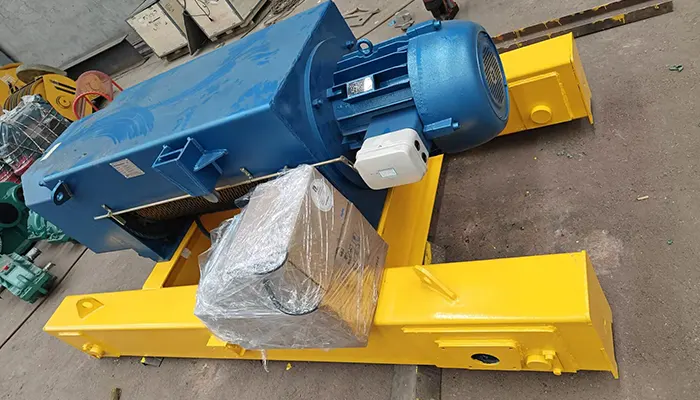
Double girder cd/md crab hoist trolley , more cost-effective wire rope electric hoist solution
Initial Investment for 20 Ton Hoists:
The initial investment for 20-ton hoists encompasses various expenses associated with acquisition, installation, and setup:
- Equipment Cost: The primary component of the initial investment is the cost of the 20-ton hoists themselves. This includes the base price of the hoists, as well as any optional features, customization, or accessories.
- Installation Expenses: Costs related to hoist installation, such as labor, transportation, rigging, and structural modifications, contribute to the initial investment. These expenses vary depending on the complexity of the installation site and the scope of work required.
- Electrical Infrastructure: Upgrading or installing electrical infrastructure to support hoist operation, including power supply, wiring, and control systems, adds to the initial investment. Electrical work must comply with safety regulations and may require professional installation services.
- Regulatory Compliance: Expenses associated with regulatory compliance, such as obtaining permits, conducting inspections, and meeting safety standards, are part of the initial investment. Compliance ensures legal operation and minimizes the risk of penalties or liabilities.
Operating Costs:
Operating costs encompass ongoing expenses incurred during the operational lifespan of 20-ton hoists:
- Energy Consumption: Hoist operation requires electrical power, resulting in energy consumption costs. Monitoring energy usage and implementing energy-efficient practices, such as optimizing load capacities and minimizing idle times, can help control operating costs.
- Maintenance and Repairs: Regular maintenance is essential to preserve hoist performance and prevent breakdowns. Budgeting for routine inspections, lubrication, and repairs ensures optimal hoist operation and minimizes downtime.
- Spare Parts and Consumables: Stocking spare parts and consumables, such as wire ropes, brake pads, and electrical components, is necessary to address wear and tear and respond to unexpected failures promptly.
- Operator Training: Training programs for hoist operators incur ongoing costs for materials, instructor fees, and employee time. Investing in comprehensive training ensures safe and efficient hoist operation, reducing the risk of accidents and injuries.
Return on Investment (ROI) Analysis:
Calculating the return on investment (ROI) helps evaluate the economic viability and long-term benefits of deploying 20-ton hoists for double girder cranes:
- Productivity Gains: Assess the potential productivity gains enabled by hoist deployment, such as increased lifting capacity, faster cycle times, and improved operational efficiency. Quantifying the impact on production output and labor utilization provides valuable insights into ROI.
- Cost Savings: Identify cost savings realized through hoist deployment, such as reduced manual labor requirements, minimized material handling times, and decreased downtime due to equipment failures. These savings contribute directly to ROI and justify the initial investment.
- Safety Improvements: Factor in the intangible benefits of improved safety and risk mitigation achieved through hoist deployment. Avoiding accidents, injuries, and associated costs enhances ROI by safeguarding personnel and assets and preserving operational continuity.
- Lifecycle Analysis: Consider the total cost of ownership over the hoist's lifecycle, including initial investment, operating costs, maintenance expenses, and potential salvage value. Analyzing these factors over time provides a comprehensive view of ROI and informs strategic decision-making.
By conducting a thorough analysis of initial investments, operating costs, and potential ROI, stakeholders can make informed decisions regarding the deployment of 20-ton hoists for double girder cranes. Balancing cost considerations with performance, safety, and long-term benefits ensures optimal outcomes and maximizes value for industrial operations.
Conclusion
In conclusion, the deployment of remote control 20-ton hoists for double girder cranes offers significant advantages in terms of efficiency, safety, and operational flexibility. Let's recap the key points discussed, emphasize the importance of remote control hoists, and provide final recommendations for procurement and implementation:
Recap of Key Points:
- Remote control 20-ton hoists provide precise load handling capabilities and enhanced maneuverability, making them ideal for various industrial applications such as mining, construction, and manufacturing.
- Considerations such as altitude, climate conditions, regulatory compliance, and cost factors play crucial roles in the customization, installation, and operation of these hoists.
- Safety protocols, operator training, emergency procedures, and compliance with local regulations are paramount to ensure the safe and reliable operation of 20-ton hoists.
- Real-world case studies and customer testimonials underscore the effectiveness and benefits of remote control hoists in optimizing productivity, improving safety, and achieving operational excellence.
Importance of Remote Control 20 Ton Hoists:
Remote control 20-ton hoists offer unparalleled advantages in terms of precision, efficiency, and safety in material handling operations. By enabling operators to remotely control hoist movements from a safe distance, these hoists enhance operational flexibility, productivity, and risk mitigation. The ability to navigate confined spaces, maneuver heavy loads with precision, and respond quickly to changing conditions makes remote control hoists indispensable assets in industrial settings.
Final Recommendations for Procurement and Implementation:
When procuring and implementing remote control 20-ton hoists, it's essential to:
- Conduct a thorough assessment of operational requirements, site conditions, and regulatory compliance considerations.
- Collaborate with reputable hoist manufacturers and suppliers with a proven track record of delivering high-quality products and reliable customer support.
- Prioritize operator training, safety protocols, and emergency procedures to ensure safe and efficient hoist operation.
- Perform regular maintenance and inspections to preserve hoist performance and prolong equipment lifespan.
- Monitor key performance indicators and conduct periodic reviews to evaluate the effectiveness and ROI of hoist deployment and identify areas for improvement.
In summary, remote control 20-ton hoists represent a transformative solution for material handling operations, offering unmatched capabilities and benefits that empower industrial organizations to overcome challenges, optimize performance, and thrive in today's competitive marketplace.
Related Products

Latest project
150 Ton Overhead Crane Installation Feedback – Paraguay Case
QDX 150 ton overhead crane in action in Paraguay. Installation photos, video, and client feedback show performance, safety, and heavy-lifting efficiency.
Free consultation to Confirm Parameters & Specifications and Get
Latest Crane Price & Crane Rate.
- Types of overhead cranes : _______?
- Optional: Overhead travelling crane, goliath gantry crane,Slewing jib crane, Single girder or double girder crane,small portable crane or kbk crane, etc.
- Capacity of overhead crane: _______?
- Optional: 0.25ton, 0.5 ton, 1 ton, 2 ton, 3ton, 5 ton, 10 ton,15ton, 20ton, 25 ton, 30ton,35ton, up to 550ton, etc.
- Crane span & lifting height : _______?
- Crane travelling length : _____?
- Control of overhead crane:_______?
- Optional: pendant/ remote/cabin control
- Voltage supply of overhead crane:_____?
- Eg,: 380V50/60HZ,3Phase or others,etc.
- Application/usage of crane:_______?
- Eg,: Steel mill, ,injection mold, cement,stone, concrete,granite, general manufacturing, etc.
Just leave a message via the contact form and our hoist and crane engineer will contact you with in 24working hours.
Get In Touch
